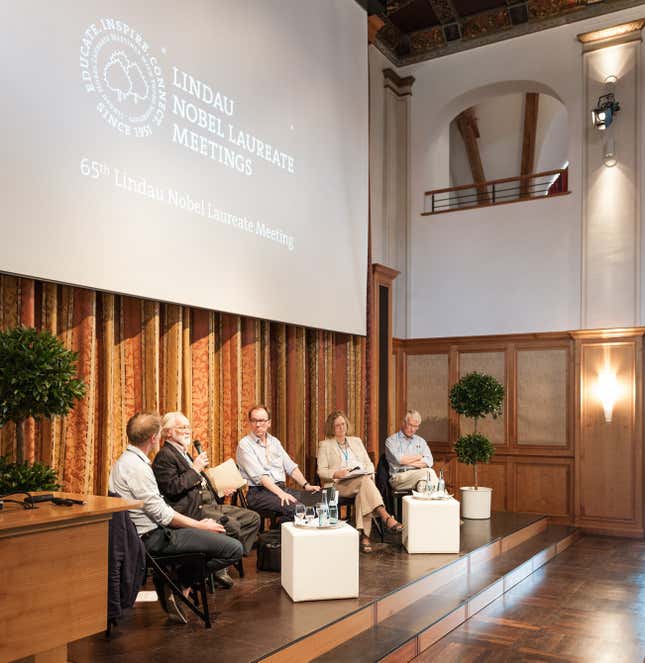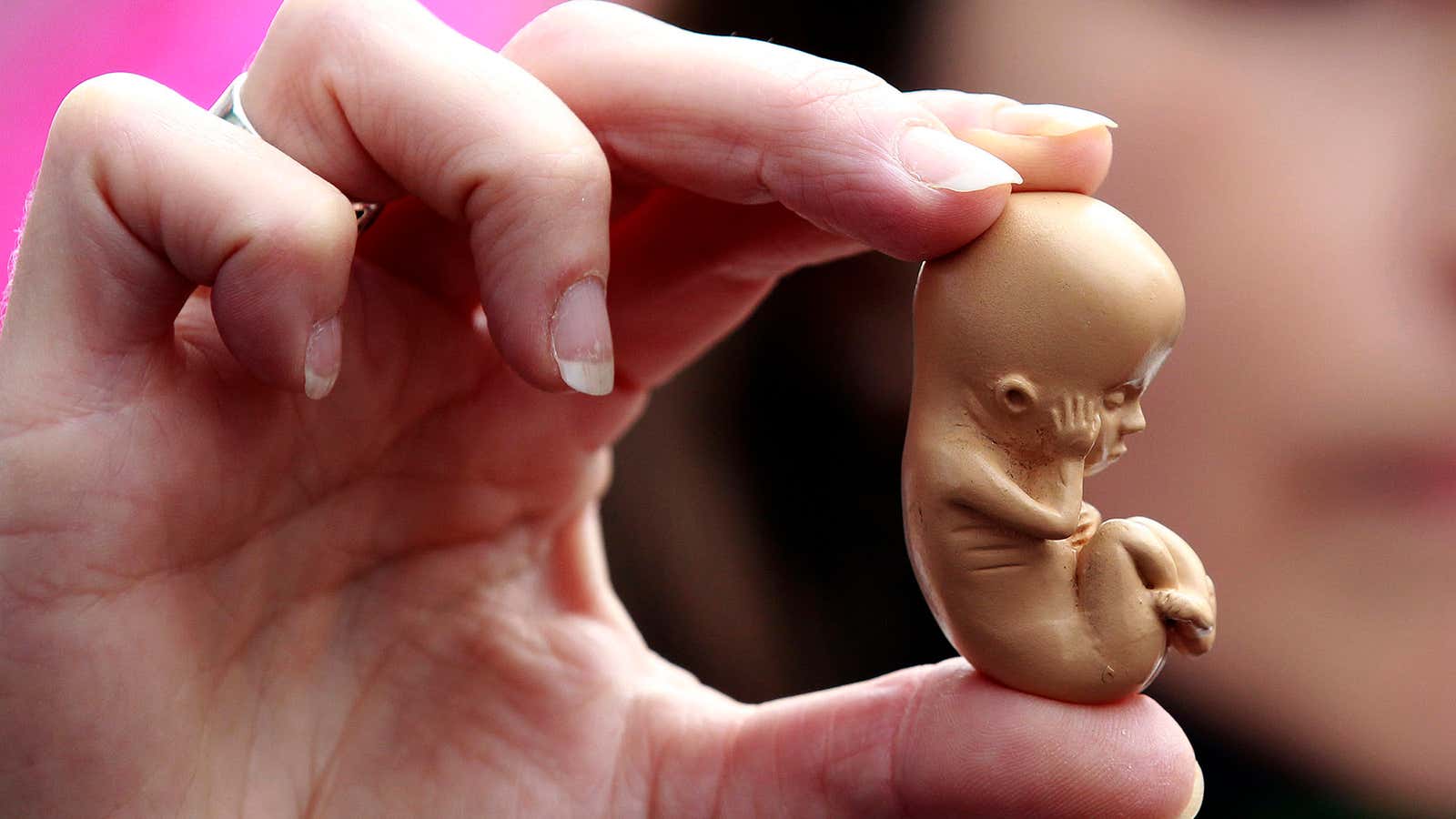Lindau, Germany
We’ve avoided a nightmare before, so surely we can do it again. That’s what scientists hope for with the technology that may soon allow the genetic modification of human embryos.
In March, a group of US scientists requested scientists around the world to not genetically modify human embryos. They argue that the technology is not ready yet, but, less than a month later, a group of researchers in China did just that.
The technology in question—referred to as CRISPR—can be used to make genetic modifications with greater precision than ever before. It works like a biological find-and-replace tool: you can program the system to seek out a certain genetic sequence in a cell, and then replace it with another sequence.
It is also cheap and easy to use, and could one day soon be used to treat genetic disorders, such as sickle cell anemia, and eliminate heritable diseases, such as cystic fibrosis. Yet the flip-side of the technology is the creation of genetically enhanced humans and the social upheaval that could follow.
The Chinese scientists were trying to fix the faulty genes in embryos that are known to cause the blood disorder thalassaemia. They justified their experiments by saying that they used abnormal embryos that were going to be discarded anyway. But there is a worry that not all scientists in China will stop there—and some may experiment with viable embryos.
GM humans
This opinion was expressed by three Nobel laureates on June 29 at a meeting in Lindau, Germany. Michael Bishop, Richard Roberts, and Elizabeth Blackburn—who are well-known for their work in genetics—said that while Western scientists will be able to come to a global consensus regarding the use of CRISPR, they are not sure if scientists in China would agree to a moratorium on genetic modification of human embryos.

CRIPSR technology, they argued, is not close to ready for tests in humans. If such tests are carried out in embryos, the changes made will be passed on to their descendants, which could have adverse effects on future humans. Though CRISPR is the most precise tool for genetic modification, it is not precise enough.
How to manage a superpower
When they faced a similar situation four decades ago, scientists showed the world how a global consensus on the use of genetic engineering with unknown risks should be handled.
In 1974, the Stanford biochemist Paul Berg found a way of mixing the DNA of different species to create a hybrid organism (if the new DNA is injected in to a host cell). The two species involved in Berg’s experiment were the monkey virus SV40, which is known to cause cancer, and E. coli, a bacteria that is found in the human gut. He feared that, if the hybrid organism escaped the lab, it could cause cancer.
More broadly, Berg’s technology could allow others to mix even more dangerous species. That’s why, even though the hybrid DNA was ready, Berg never injected it in to a host cell. Instead, he set about organizing a conference on his “recombinant DNA” technology.
At the Asilomar Conference—named after the conference center it was held in—scientists agreed on common principles of using recombinant DNA safely and set guidelines, such as prohibiting the experiments from being run in contagious, disease-causing microbes. Today recombinant DNA technology is widely used, and there haven’t been any major issues that have arisen from its use because scientists followed guidelines.
Enter the dragon
Now scientists are looking to organize another Asilomar-like conference to discuss the risks of genetic engineering humans with CRISPR. This time, however, the world is a different place. The 1974 conference had 140 scientists, which included the majority of those who worked on recombinant DNA technology. CRISPR is so widely used that it would be hard to fit all of them in one room.
More importantly, those 140 scientists at Asilomar came from only a handful of Western countries. Now, among researchers from other non-Western countries, China will also be at the table. And nobody is sure if the country that is spending large sums to become a world leader in biomedical science will be agree to rules set by Westerners.
In 2013, according to China’s National Bureau of Statistics, the state invested more than $190 billion on scientific research and development. “These days, if you pick up a biology journal, the list of authors invariably contains one or many Chinese names and often many of them are leading authors,” Nobel laureate Peter Agre said at a session in Lindau on the rise of science in the developing world.
“I don’t think China wants to take a moratorium. People are saying they can’t stop the train of mainland Chinese genetics because it’s going too fast,” Huso Yi, the director of research at the Chinese University of Hong Kong Center for Bioethics told the New York Times.
In 2014, Quartz reported about a Shenzen-based company that is mapping the genes of math geniuses in the hope of screening embryos to pick the smartest one. Traits such as intelligence are heritable, but their genetic basis is known to be quite complex. The company doesn’t do any genetic engineering, but if it’s successful in understanding the complexity of the genes involved and has a technology to engineer the embryo then there would be great temptation to use it.
“Confucian thinking says that someone becomes a person after they are born. That is different from the United States or other countries with a Christian influence, where because of religion they may feel research on embryos is not ok,” Deng Rui, a medical ethicist at Shanxi Medical University, told the New York Times.
Leading scientists in China do recognize that CRISPR is not ready for use in viable human embryos. The April paper, according to what Richard Roberts said at Lindau, was an excellent cautionary tale since the researchers only managed to replace a faulty gene in a handful of embryos of the 86 that were tested. Worse still, there were other unintended genetic changes made, which is something it was hoped CRISPR would avoid.
But, as Zhai Xiaomei, a member of the country’s National Medical Ethical Committee and a professor at Peking Union Medical College told the New York Times, “Inside China, there are people who are opposed to international standards, citing cultural differences. This force is actually quite powerful sometimes.”
